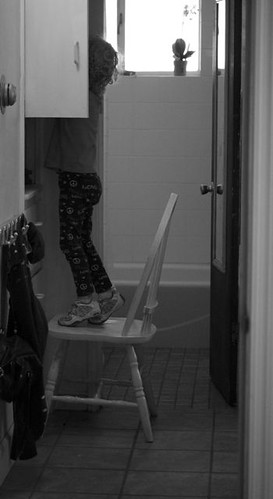
I'm thinking about sawing off the legs of the dining room chairs, or perhaps getting rid of them completely. This new look for our dining room might cause a few raised eyebrows. I could pass it off as a traditional Japanese dining room. Right?
Why am I considering such drastic measures? There is a new sound in our house that requires attention- the sound of a dining room chair being dragged by my preschooler to one location or another. The chair is utilized to get into all sorts of hiding places previously out of reach. The particular occasion that has me reaching for a saw was finding my daughter digging for those character adhesive bandages (Band-Aids etc.) in one part of the first-aid kit. This first-aid kit is almost entirely bandages, gauze and the such with a little antibiotic cream for good measure, but the box with cough syrups and tablets was just one shelf higher and with a good tug it could be all over the floor. I think she knows better than to get into it, but why risk it? There is a better option than sawing off the chair legs - childproof our medicines.
1. Get rid of the old, outdated medications
A quick peruse through our medication box revealed a ridiculous amount of expired medications including cherry cough syrup that might inspire concerted efforts to access by a small child. Accidental poisonings can be fatal. No need to keep what isn't needed or isn't current. Bag the expired, outdated and no longer used medications and take them to be disposed off properly. Here in Pima County we can drop the medications off at the City of Tucson Household Hazardous Waste Program or you can go down to The Medicine Shoppe who has a permanent drop off. It is tempting to flush them down the toilet, but that then adds those medications to our water supply. There are protocols that are drug specific for medicine disposal if you aren't able to get to one of these drop off points. Check the Food and Drug Administration for information about disposal of medicines and for more information about the environmental impact on our water check here.
2. Check all current medication containers
Are the caps screwed on right? Are they in childproof containers? Late at night, early in the morning, or when you're not feeling great sometimes getting the cap back properly on the container didn't happen. Check all the containers and make sure they're firmly shut.
3. Safe Storage
Don't leave medication bottles out and about, safely store your medications out of reach of children. Medications on the side of the sink are within easy reach. In our house we now have a specific shelf for all current daily medications that is now far beyond the reach of a child with a chair, in a cabinet with a latch. Everything that isn't used on a daily basis is in a box with clasps, high on a shelf, behind a cabinet that also now has a childproof latch on. Yes, it takes a little longer to get to the medication, but my child is worth an extra thirty seconds or so and so is your child. Remember, it doesn't have to be the bathroom, in fact the humidity and condensation of bathroom makes it a poor place to store medications.
Don't leave medication bottles out and about, safely store your medications out of reach of children. Medications on the side of the sink are within easy reach. In our house we now have a specific shelf for all current daily medications that is now far beyond the reach of a child with a chair, in a cabinet with a latch. Everything that isn't used on a daily basis is in a box with clasps, high on a shelf, behind a cabinet that also now has a childproof latch on. Yes, it takes a little longer to get to the medication, but my child is worth an extra thirty seconds or so and so is your child. Remember, it doesn't have to be the bathroom, in fact the humidity and condensation of bathroom makes it a poor place to store medications.
No comments:
Post a Comment